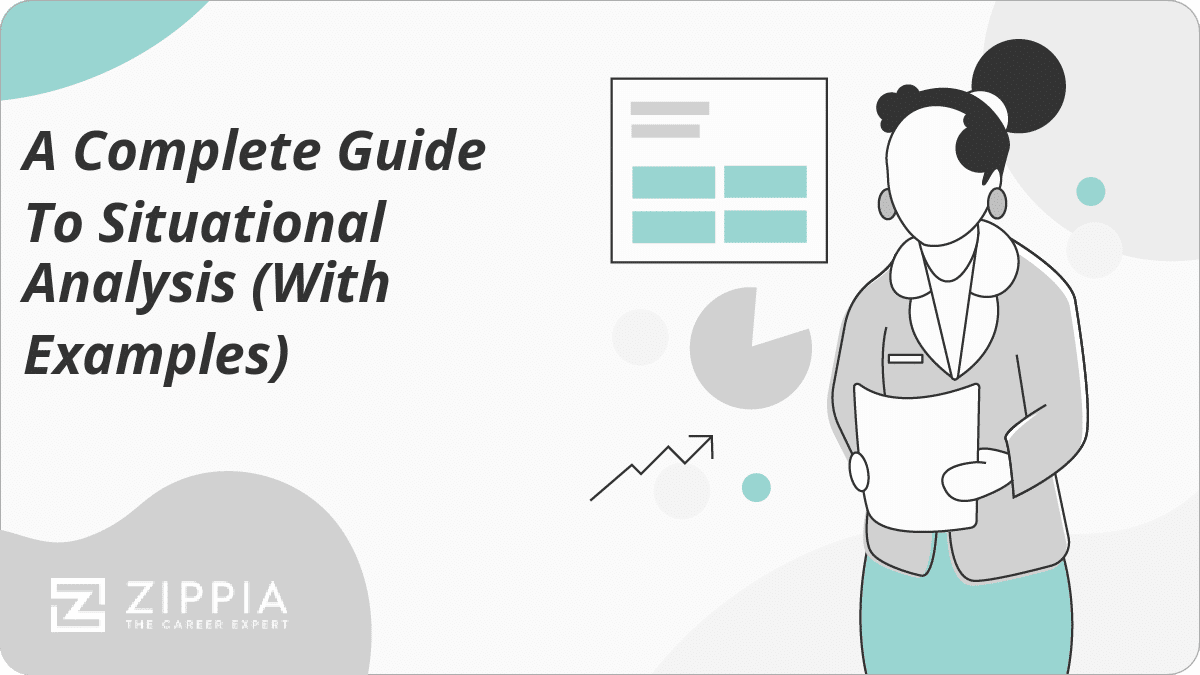A Complete Guide To Situational Analysis (With Examples)
Summary. Situational Analysis is used to assess the internal and external factors of a business. It is used to help determine a business’ strengths, weaknesses, potential new customers, and any issues that may be there. The three popular methos of situational analysis are SWOT analysis, 5C’s analysis, and Porters Five Forces.
- Situational analysis assesses the internal and external factors of a business to clarify its advantages and disadvantages.
- A situational analysis is particularly useful before launching a new project or marketing campaign.
- There are many ways to perform a situational analysis such as, the SWOT analysis, the 5 C’s Analysis, and Porter’s Five Forces.
- A useful situational analysis should be practical, easy to understand, provides equal attention to internal and external factors, and sets goals for your business.
Hire Faster And Easier Post A Job

In This Article
Skip to section
- What Is a Situational Analysis?
- Factors to Consider in Situation Analysis
- Why Is a Situational Analysis Important?
- Methods of Situational Analysis
- What Is SWOT Analysis?
- What Is the 5C’s Analysis?
- What Is a Porter Five Forces Analysis?
- How to Complete a Situational Analysis
- Qualities of Useful Situational Analysis Results
- Challenges Of Situational Analysis
- Situational Analysis FAQ
- References
- Sign Up For More Advice and Jobs
What Is a Situational Analysis?
A situational analysis is a method used to assess the internal and external factors of a business. It identifies both the advantages a business enjoys and the challenges that it is likely to face.
The ultimate goal of situational analysis is to determine a business’ strengths, weaknesses, potential new customers, and lingering issues that contribute to the company’s general standing. Multiple different methods of analysis are used to complete this evaluation, and they’re often used in conjunction with one another.
Factors to Consider in Situation Analysis
Usually, situational analysis is started before launching a new project or embracing new marketing strategies. A situational analysis incorporates a few factors for consideration. These include:
- Competition. Determine what steps you want your company to take by comparing the advantages you have over your competition and vice versa.
- Product. Understand your product, whether it is a good or service. If you have multiple products, make sure to analyze them independently and assess how they relate to one another.
- Distribution. Analyze how your product moves through the supply chain from beginning to end.
- Customers. Know who your current customers are and who you want your prospective customers to be.
- Market Environment. The environment of your market includes your industry and localized economy, as well as your relationship to suppliers and customers.
The purpose of conducting a situation analysis is to get a better understanding of the factors that will affect your company’s success. The results of a situational analysis give the business insight into how to move forward.
Why Is a Situational Analysis Important?
A situational analysis is important because there’s no way to fully grasp the scope of mitigating factors that impact the outcome of a company without implementing it in some form. It’s running an organization blindly.
A situational analysis describes the work environment for what it does well, where it needs improvement, and where the likeliest avenues of growth are.
Hire Faster And Easier Post A Job
Methods of Situational Analysis
Companies use several different methods to outline their overall performance and decide on what actions they should take next. A comprehensive situational analysis uses at least two of these methods to evaluate a company’s status.
Popular methods of situational analysis include:
- SWOT analysis
- 5C’s analysis
- Porter five forces
Hire Faster And Easier Post A Job
What Is SWOT Analysis?
A SWOT analysis is a method of situational analysis that relies on taking stock of your Strengths, Weaknesses, Opportunities, and Theats. It;s a popular method of situational analysis. There are four main areas that this SWOT analysis looks into:
- Strengths. Evaluating a company’s strengths asks you to determine what they do well. These can be positive aspects of their product, customer relations, or any other feature that acts as a strength.
- Weaknesses. While many organizations are vocal and aware of their strengths, they may be less willing to face their weaknesses. However, understanding a company’s weaknesses and what areas these reside in is crucial to improvement.
- Opportunities. Gathering a company’s opportunity pool is often a lot of brainstorming. Opportunities are places that the business expands to further its success. This could be in the form of catering to a new customer base or entering an emerging market.
- Threats. More than any other piece of the SWOT analysis, the threats portion asks a business to think about external factors. These are outside entities or aspects that hurt a business and can lead to failure down the line.
These broad aspects are the qualities that determine a business’ current standing, future options, and potential problems.
What Is the 5C’s Analysis?
The 5C’s analysis serves a similar function to the SWOT, but it’s used as a framework for marketing, rather than determining a company’s overall health. Understanding the 5C’s establishes marketing strategies that put a business ahead of its competition.
- Company. Even though the 5C method of analysis deals with marketing and competition, the first step is to look inward at your own company. Consider your business’ abilities, products, current marketing, and financials. Take stock of where your company stands. Beginning with the SWOT analysis helps create a well-rounded evaluation for the first C.
- Customers. Now that a picture of your company has been established, shift attention to the customer base. Ask yourselves what your company’s customers need and want. This leads to better communication between an organization and the individuals it serves. This can be done through either open discussion, polls online, or setting up official consumer testing.
- Competitors. In any kind of business, knowing your competitors is how your company eventually surpasses them. If you don’t know who your company’s top competitors are, do some market research into the subject. When you have a firm grasp on who your team competes with, dig deeper into these brands and their marketing strategies.
- Collaborators. The collaborators involved with your company are the exact opposite of the competition. It’s organizations that you could have a symbiotic relationship with. They’re investors or other businesses that you could potentially have a professional partnership with in the future.
- Climate. The final aspect to assess through the 5C’s analysis is climate. This refers to the environment that your company is functioning in. That could refer to your business’ specific field or more global events that impact a variety of industries. Evaluating climate is crucial to understanding the conditions your company is working under and establishing an effective plan within these confines.
Hire Faster And Easier Post A Job
What Is a Porter Five Forces Analysis?
Competition is a huge aspect of a business’ success in its market. The Porter Five Forces analysis highlights this principle by evaluating competition to assess threats and using this knowledge to further your own company.
The elements of the Porter Five Forces are:
- Evaluating existing competition. The first factor that the Porter Five Forces asks businesses to establish is the number of competitors they have and how strong they are. The number of competitors in your company’s industry and the size of those corporations describe your business’s power within the market.
- The threat of substitutes. The threat of substitutes refers to the ability of a company’s product to be recreated. A company whose product or service has no similar substitutes has more control and power in the market.
- The threat of new entrants. A company’s standing is also determined by how easily new competitors can enter their field in the future. Industries that are hassle-free to enter and become a valid competitor weaken the power of businesses participating overall.
- Bargaining power of customers. Small businesses are often the most affected by the bargaining power of customers. This means how influential the customers are to driving a product’s price up or down. The more customers a business has, the less individual power they have over the price and company. Alternatively, the customer base of small businesses has the power to impact their prices significantly.
- Bargaining power of suppliers. Finally, the bargaining power of suppliers makes up the last tier of a complete competition picture. Just about every brand requires unique supplies to create their products, and these have to come from somewhere. In industries with many suppliers available, each one has less bargaining power. Businesses that function in markets with fewer suppliers carrying the items they need give each supplier more control over costs.
Hire Faster And Easier Post A Job
How to Complete a Situational Analysis
- Choose a method of analysis. To complete a situational analysis at your company, first, choose a method that you’ll be using for evaluation. Many companies begin with the SWOT analysis because it provides the most comprehensive picture of a business’ status in terms of what it does well and how it could improve.
- Complete the method’s guidelines. The second step to a situational analysis is the fairly simple direction of following your chosen method’s guidelines.
- Reproduce with another method of analysis. Finally, reproduce your company’s situational analysis using a different method. Run through its steps completely. It’s recommended to perform all three methods of analysis for the most complete results and best strategy formulation.
Hire Faster And Easier Post A Job
Qualities of Useful Situational Analysis Results
- It’s easily understandable. A company’s situational analysis results should be easily understandable. Someone who doesn’t work at your company or in your field should be able to understand it.
- It’s practical. The point of conducting a situational analysis of a business is to gather useful data and formulate practical marketing strategies. If the results from a situational analysis are impractical and have no use, then the process was a waste.
- Equal attention to external and internal factors. A business is never solely affected by internal or external factors. It’s a combination of both. A useful situational analysis pays equal attention to aspects inside and outside the business.
- Inspires more company analysis. Beginning the discussion about where a company currently stands in the market and their potential outlets for improvement gets the ball rolling on future analysis. Practical analysis almost always ends with inspiration for more later on.
- Includes goals for the future. Situational analysis isn’t just about the current status of your company but also setting intentions for expansion. A huge part of successful situational analysis is the formulation of goals for the future because, without them, the business simply remains stagnant.
- Outlines plans for these goals. In addition to setting goals for your company’s future, useful situational analysis results in outlining a plan for how this feat will be accomplished. The plan doesn’t need to be set in stone, but there should be some groundwork to back up the intention of reaching the goals presented by situational analysis.
Challenges Of Situational Analysis
Making a situational analysis is not always easier. Sometimes your company will have issues along the way. Common challenges include:
- Cluttered or conflicting priorities during analysis.
- Factors lacking objectivity.
- Information is poorly organized.
All of these issues will doom a situational analysis if they are not handled properly. Remember, it is important that your situational analysis creates a clear picture that both your business and outsiders can easily understand.
Ready To Start Hiring? Post A Job
Situational Analysis FAQ
- Is situational analysis the same as SWOT?No, situational analysis is not the same as SWOT. SWOT is one method for conducting a situational analysis. SWOT is an acronym that stands for Strengths, Weaknesses, Opportunities, and Threats.
- What is situational analysis used for?Situational analysis is used to create a framework from which a plan can develop. Performing a situational analysis is the first step toward setting priorities, delegating tasks, carrying out processes, and ultimately evaluating the success of a project.
- What are the basic components of situational analysis?The basic components of situational analysis in SWOT are:
- Strengths
- Weaknesses
- Opportunities
- Threats
The basic components of situational analysis in the 5C’s analysis are:
- Company
- Customers
- Competitors
- Collaborators
- Climate
The basic components of situational analysis in a Porter Five Forces analysis are:
- Evaluating existing competition
- The threat of substitutes
- The threat of new entrants
- Bargaining power of customers
- Bargaining power of suppliers
Ready To Start Hiring? Post A Job
References
How useful was this post?
Click on a star to rate it!
Average rating / 5. Vote count:
No votes so far! Be the first to rate this post.
Skills Based Articles
Specific Skills
- What Is Figurative Language?
- What Are Rhetorical Strategies?
- What Is a Subject Matter Expert and What Do They Do?
- What Is A Differentiation Strategy
- What Is Job Order Costing
- What Is Situational Analysis
- Plan Of Action
- Report Format
- Law Of Diminishing Marginal Returns
- Administrative Duties
- Giving A Presentation
- Organizational Behavior Management
- Deductive Reasoning
- Reflective Listening

Sky Ariella is a professional freelance writer, originally from New York. She has been featured on websites and online magazines covering topics in career, travel, and lifestyle. She received her BA in psychology from Hunter College.


Create Resume


What Is A Visual Learner?

50 Jobs That Use Html The Most


Master’s In Education Jobs [10 Best-Paying + 10 Entry-Level Jobs You Can Do With An Education Degree]


Important Multitasking Skills Employers Value (With Examples)
- Zippia >
- Career Advice >
- Skills >
- Situational Analysis












